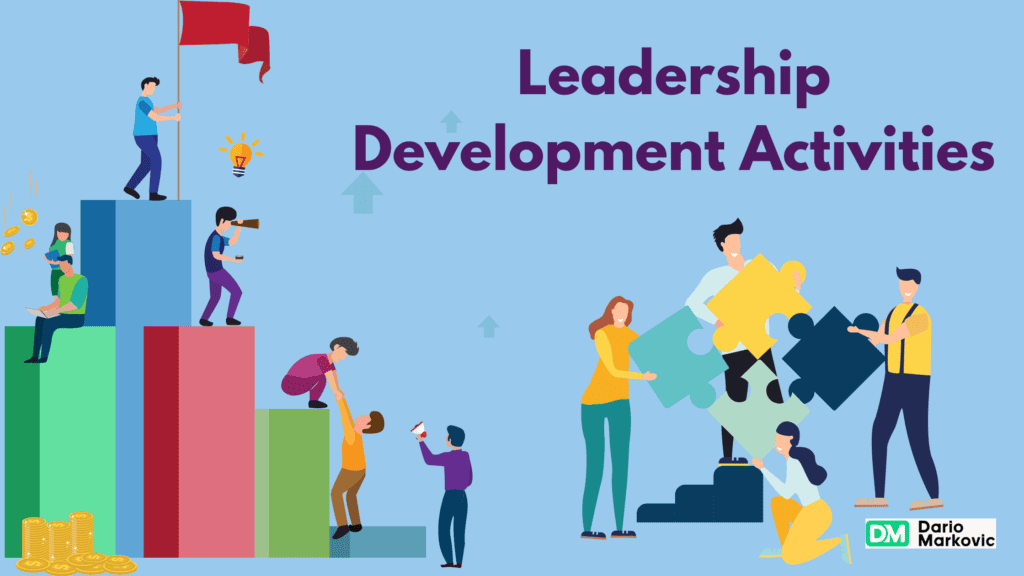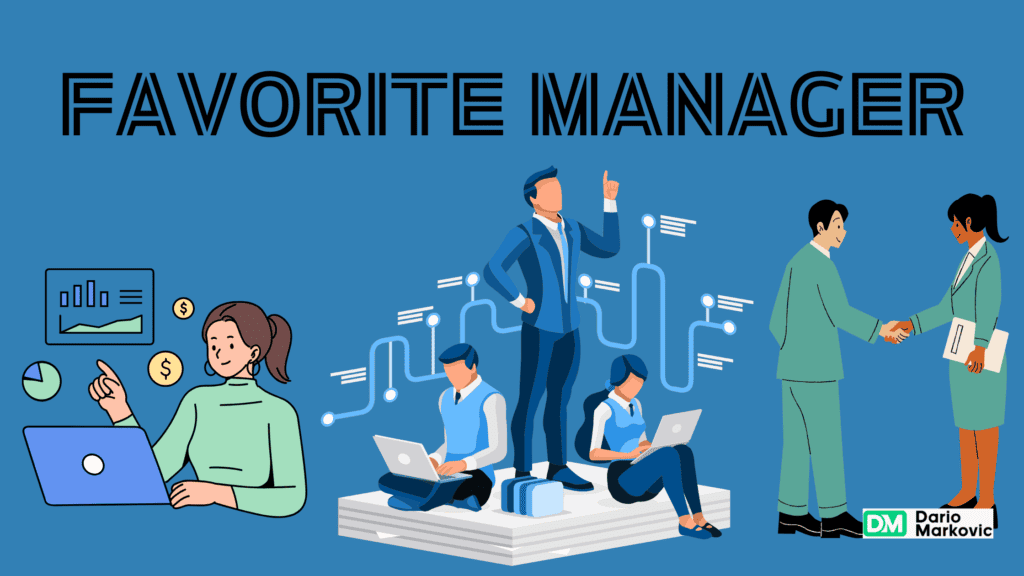Leaders often find themselves at a crossroads, seeking ways to boost their teams’ morale while sharpening their leadership skills.
Leadership development activities serve as the compass that guides them through this journey.
They highlight survival scenarios for testing adaptability, roundtable discussions to promote collaboration in every team member, and targeted exercises to hone decision-making skills.

You’ll unearth methods to weave together the fabric of team unity and ignite a flame of creativity within your team members.
Prepare to delve into leadership development activities where these endeavors sculpt adept team leaders and weave closer, more articulate squads poised to confront any obstacle.
The Essence of Developing Leadership Skills
Activities to develop leadership skills are much more than a mere item on the corporate list of things to do.
They’re the secret ingredient that transforms the ordinary Joe into Captain America or a highly efficient leader who inspires the team to be great.
These leadership exercises are essential to improve leadership abilities and strengthen team cohesion in the fast-paced business world.
What are Leadership Development Activities?
Developing leadership involves specific exercises to improve essential qualities like decision-making ability, active listening, communication skills, and critical thinking.
It’s more than developing individual skills and creating an environment where teamwork flourishes for all team members. According to research published by Sling, participating in these leadership team building activities can significantly improve problem-solving, communication efficiency, trust between the group, and overall team involvement.
To put this into context, consider how simple tasks like the marshmallow challenge foster the ability to think critically and solve problems, teaching essential lessons about collaboration under pressure.
These seemingly fun but highly effective leadership exercises prepare future leaders to take on actual challenges head-on.
Innovative Team Building Exercises for Leadership Growth
Fostering leadership skills within a group hinges on the core practice of team development activities.
Creative exercises push individuals beyond their comfort zones, encouraging growth in unexpected ways and promoting a new leadership style.
For instance, survival scenarios test adaptability, while round-table discussions promote open dialogue among group members, nurturing a culture of mutual respect and collective brainstorming showcasing successful leadership.
SessionLab highlights several unique approaches.
This hands-on approach helps identify emerging leaders capable of steering their groups toward achieving common goals, effectively forging stronger bonds between team members. Stats from sources like SessionLab further underscore the importance of communication trust in building successful dynamic environments that increase productivity satisfaction across the board, even with different leadership styles.
Key Takeaway:
The best leadership development activities are game-changers.
They turn ordinary folks into standout leaders by boosting skills like decision-making and teamwork.
From creative problem-solving exercises to survival scenarios, these activities strengthen teams and foster a culture of respect and productivity among team members.
This will help your team get ahead in this leadership race.
Step-by-Step Innovative Team Building Exercises for Leadership Growth

Team building exercises are not just about having fun; they’re a strategic tool to enhance group cohesion and spotlight potential leaders.
We delve into unique activities beyond the usual scope of leadership concepts.
Step 1: Survival Leadership Activities
When discussing survival scenarios, we put teams in situations where adaptability and teamwork are tested to their limits.
Imagine your team stranded on an island or lost in the wilderness—only through working together can they “survive.”
These high-pressure situations help identify who steps up as a leader when it counts most. Explore Sling’s comprehensive manual on orchestrating leadership activities to delve deeper into crafting these dynamic environments.
Nudging teammates into unfamiliar territory fosters enhanced communication and swift decision-making—critical traits of adept leadership.
Step 2: The Round Table Discussion
A less intense but equally effective exercise is the round table discussion. In this setting, each participant is empowered to share their perspectives, fostering a culture of inclusive conversation among the group.
Leaders naturally stand out by demonstrating their ability to attentively listen, actively engage with differing viewpoints, and constructively offer their insights.
By adopting this method, we cultivate a team-oriented atmosphere that treasures every perspective, an essential element for nurturing effective leadership. Are you interested in implementing this?
Swing by SessionLab to scoop up some strategies for sparking effective conversations.
Remember: The goal isn’t just finding those who speak loudest but uncovering those capable of inspiring others to take action toward achieving common objectives.
Through innovative team-building exercises like survival challenges or thoughtful discussions, you strengthen group cohesion while highlighting individuals with potential leadership qualities critical for any organization’s growth.
Step 3: Icebreaker Challenges
Icebreaker games are an excellent way to break the ice in team dynamics, fostering better camaraderie.
Imagine starting a meeting with an activity that lightens the mood and improves listening and speaking skills.
Games like ‘Two Truths and a Lie’ encourage participants to pay attention while learning fun facts about their colleagues, breaking down barriers, and promoting clear interaction.
This sets a precedent for open, effective communication throughout collaboration, benefiting interpersonal relationships and achieving common goals.
These exercises lay the groundwork for more complex teamwork activities where communication is crucial.
Mastering communication through engaging exercises promotes clarity among team members, enhancing problem-solving skills and decision-making.
Effective communication is vital for any team leader aiming for success.
Step 4: Impact and Effort Matrix Application

Engaging in this activity enhances decision-making and group communication toward a common goal.
Tasks are categorized into high impact-low effort (quick wins), high impact-high effort (significant projects), low impact-low effort (fill-ins), and low impact-high effort (thankless tasks). Leaders prioritize effectively, honing core skills like active listening and critical thinking.
These activities simultaneously cultivate leadership skills and strengthen team unity through shared achievements. Beyond individual methods like the Impact and Effort Matrix, broader strategies improve overall organizational leadership quality.
Developing situational leadership skills allows team leads to adapt their style as needed, whether providing direct guidance or empowering others.
Strategies for Effective Decision-Making in Leaders

Effective decision-making is crucial for leaders. Leaders can improve effectiveness by making informed, quick, and precise choices.
Clear and effective team interaction isn’t just lovely; it’s essential. Leadership exercises that refine dialogue capabilities are crucial because they improve decision-making and troubleshooting.
They can enhance their decision-making skills through distinct activities tailored to this goal.
Dotmocracy Technique

The Dotmocracy technique is a democratic decision-making approach involving all team members.
Employing this strategy fosters an environment where each participant’s input is valued, enhancing the group’s collective wisdom and fostering a spirit of unity.
| Pros: | Cons: |
| Simple and Visual: Dotmocracy is a straightforward and visual method that allows participants to understand and engage in decision-making quickly. It requires little training or explanation. | Limited Depth of Analysis: Dotmocracy is a simple method that may not allow in-depth analysis or consideration of complex issues. It prioritizes popular options over potentially more nuanced or innovative ideas. |
| Equal Participation: It provides an opportunity for equal participation from all participants. Each person typically receives the same number of dots or stickers, ensuring everyone’s opinion is considered. | Bandwagon Effect: There’s a risk of the bandwagon effect, where participants may vote for already popular options or have received many dots, regardless of their preferences or critical evaluation of the possibilities. |
| Quick and Efficient: Dotmocracy can quickly and efficiently gather feedback or make decisions, particularly in large groups or when time is limited. It allows for a relatively fast aggregation of preferences. | Potential for Dominance: Certain individuals or groups within the larger group may dominate the dotmocracy process, influencing the outcome disproportionately. This can undermine the democratic nature of the method. |
| Transparent: The process is transparent, as participants can see the votes accumulating on the board or chart in real-time. This transparency can help build trust among participants and ensure accountability in the decision-making process. | Lack of Context: Dotmocracy may need more context or background information about the options being voted on, leading to uninformed decisions or biases based on surface-level characteristics of the options. |
| Encourages Collaboration: Dotmocracy encourages collaboration and consensus-building as participants discuss and negotiate their preferences before placing their dots. It can foster a sense of teamwork and shared ownership of decisions. | Limited Usefulness for Complex Decisions: Dotmocracy may not be suitable for complex decisions that require extensive analysis, consideration of trade-offs, or expert judgment. It is best suited for simple decision-making tasks. |
Participants express their opinions on different options through dot voting – a simple yet powerful way to visualize preferences and make choices clear and straightforward.
The research underscores that when leaders engage in decision-making exercises, they enhance their skills and strengthen the bonds and trust within the team—critical ingredients for triumph.
Cultivating Critical Thinking Through Group Challenges
Critical thinking is essential to effective decision-making. It is a skill honed through challenging exercises like problem-solving scenarios or strategies designed to be played by teams.
These activities push leaders to think beyond conventional solutions and encourage innovation.
A notable example is survival simulations, where quick thinking under pressure tests the individuals’ resilience and the groups’ unity in achieving common goals. Sling’s compilation of leadership challenges offers several exercises to develop these vital skills among leaders.
| Pros: | Cons: |
| Diverse Perspectives: Group challenges bring together individuals with diverse backgrounds, experiences, and perspectives, which can enrich discussions and provide a broader range of solutions to problems. | Group Dynamics: Group challenges may be hindered by the dominance of specific individuals, groupthink, or conflicts among members, which can impede critical thinking and inhibit the exploration of diverse perspectives. |
| Collaborative Learning: Group work encourages collaboration and cooperation among members, fostering a supportive learning environment where participants can learn from one another. | Unequal Participation: In some cases, certain group members may contribute more actively than others, leading to unequal participation and limiting the opportunity for all members to develop their critical thinking skills. |
| Feedback and Reflection: Group challenges often involve peer feedback and reflection, allowing participants to gain insights into their thought processes and improve their critical thinking skills through constructive criticism. | Time Constraints: Group challenges often have time constraints, which may pressure participants to focus on reaching a solution quickly rather than engaging in thorough analysis and critical reflection. |
| Real-world Application: Many group challenges simulate real-world scenarios, allowing participants to apply critical thinking skills to practical problems and develop their ability to make informed decisions. | Confirmation Bias: Group challenges may inadvertently reinforce participants’ existing beliefs or biases if group members predominantly share similar perspectives, potentially limiting the development of critical thinking skills by not adequately challenging assumptions. |
| Enhanced Creativity: Group challenges can spark creativity as members brainstorm ideas and explore unconventional solutions to complex problems, leading to innovative approaches that may not have been considered otherwise. | Dependency: In some cases, participants may become overly reliant on group members for solutions or insights rather than developing independent critical thinking skills. |
Key Takeaway:
Boost your leadership by practicing decision-making with the Dotmocracy technique and critical thinking challenges. These activities not only sharpen skills but also build team trust and cohesion.
Key Considerations & Activities: Fostering Leader Creativity
My Favourite Manager Exercise
Participants adopt three different personas of employees and write down the traits of a positive leader or manager and one that is negative from the viewpoints of those employees.
After reflecting independently, the participants will review their lists in pairs and later in groups. Then, they will gather the top do’s and don’ts for leaders and managers.
Anything that stimulates the most profound reflection of your way of leading and the leadership styles of your role models is an excellent improvement method.

Thinking creatively is essential for solving the most challenging problems in our current work environment.
A great way to stimulate leadership with creativity is the “My Favourite Manager” exercise. This task forces leaders to consider their favorite leadership styles and determine the qualities that make these leaders successful.
In this exercise, participants are encouraged to reflect on the leaders they admire and note down traits that made them notable.

The purpose here isn’t remembering the past but identifying tangible characteristics that can be applied or incorporated into their leadership style.
The benefit of focusing on the most admired management styles is their simplicity and powerful influence on how a leader looks at team dynamics, challenges, and the ability to innovate within the company. It acts as a mirror, revealing the qualities we admire in other people and pointing out areas that we can improve.
| Pros: | Cons: |
| Reflection and self-awareness: Exercises like this can prompt employees to reflect on their experiences with different managers, helping them gain insight into their preferences, working styles, and management needs. | Subjectivity: Preferences for managerial styles can vary significantly among employees, and what one person appreciates in a manager may not be universally applicable or relevant to others. |
| Feedback opportunity: Employees can provide constructive feedback on what they appreciate in a manager, which can be valuable for managerial development and improvement. | Bias and personal opinions: Employees may base their opinions on personal biases or limited experiences, which may not provide a comprehensive or accurate assessment of managerial effectiveness. |
| Team cohesion: Discussing managerial styles and preferences can foster open communication and understanding among team members, improving collaboration and cohesion. | Potential for negativity: If employees have had negative experiences with specific managers, discussing those experiences openly in a group setting could lead to negativity or tension within the team. |
| Professional development: Employees can learn from each other’s experiences and gain insights into effective management practices, which can contribute to their professional growth. | Manager discomfort: Managers may feel uncomfortable or defensive if the feedback provided during the exercise is perceived as overly critical or personal. |
Cultivating Core Leadership Skills with Targeted Exercises
Beginning the process of developing essential leadership skills like making decisions and paying attention to and critically examining situations with a keen eye is a skill that specialized exercises can significantly improve.
Using the Impact and Effort Matrix allows leaders to determine the best tasks to accomplish by weighing the potential impact against the required effort and maximizing task priority.
This tool helps identify the kinds of projects that will bring significant results without taking up a lot of resources.
It is essential for effective management and assisting teams to achieve shared objectives.
Furthermore, by looking at the possibilities based on this model, leaders can improve their thinking skills and create an environment for high performance within the team.
Strategies for Effective Decision-Making in Leaders
Making decisions based on information quickly and precisely is a hallmark of effective leadership. Utilizing methods like Dotmocracy, which allows all team members to contribute ideas that are then decided on by a vote, can dramatically improve this skill level in leaders.
This approach ensures that everyone is included in the decision-making process.
Diverse perspectives result in more creative solutions, and group members’ more complete buy-in is encouraged.
Key Takeaway:
Boost leaders’ creativity by reflecting on admired managers to shape their style.
Use the Impact and Effort Matrix for more intelligent task prioritization and embrace Dotmocracy for inclusive, effective decision-making.
Alternatives for Continuous Improvement: Reflective Leadership

Leaders always seek to understand better how thinking deeply about their leadership approach and how they work with their team can make a difference.
By rigorously evaluating themselves and dedicating themselves to their development, leaders become exemplars their squads admire.
Heard Seen Respected Method
The Heard Seen Respected method fosters transformative team dynamics by ensuring every member’s voice is valued, creating a space for flourishing conversations. This inclusive approach illuminates unheard perspectives, promoting unity and trust within the group, ultimately driving towards shared goals.
Inclusive discussion techniques enhance communication and establish leadership as empathetic and capable of effectively guiding diverse teams. Emphasizing the importance of listening, a crucial leadership skill, enables decisions informed by diverse viewpoints.
Leaders commit to regular feedback sessions, fostering a culture of open communication, enhancing analytical abilities, and nurturing leadership qualities throughout the team. These experiences cultivate problem-solving and adaptability, which are vital in competitive workplaces.
Through reflection practices, leaders identify and develop team talent, strengthening leadership pipelines to confront future challenges. Embracing meaningful conversations distinguishes teams, fostering a culture of collaboration and innovation.
My Experience with Leadership Development Activities for the Workplace
Engaging in leadership team building activities builds leadership abilities, which is the foundation for building more unified teams and nurturing better leaders.
Participating in survival simulations helps develop a group’s flexibility while participating in group discussions encourages cooperation. Facing new problems sparks the imagination.
Be aware that communication is essential. Cohesion in teams is necessary. Skills for decision-making are essential.
Take on challenges with others by creating an environment where everyone’s sound is heard. These exercises will help you develop great leaders.
Therefore, start today. Take these leadership training lessons and apply them to your daily life. Leading successfully means that you learn continually.
Frequently Asked Questions
These activities are vital because they provide practical, hands-on opportunities for individuals to develop essential leadership skills in a safe and controlled environment. They help participants learn by doing, fostering skill development through active participation.
There is a wide range of leadership games and activities available, including but not limited to:
- Team building exercises
- Problem-solving challenges
- Role-playing scenarios
- Outdoor adventure activities
- Simulation games
- Trust-building exercises
Consider factors such as the activity’s goals, the group’s size and composition, the desired engagement level, and the specific leadership skills you aim to develop. Tailor the activity to suit the needs and preferences of your participants.
- Solicit feedback from participants through surveys or discussions.
- Observe changes in behavior or attitudes during and after the leadership training activities.
- Assess the application of leadership skills in real-world scenarios.
- Track progress toward specific leadership development goals over time.
- Online platforms and websites dedicated to leadership development.
- Books and publications on leadership training, leadership activities, and team-building exercises.
- Professional development workshops and training programs for every team member.
- Consulting firms or experts specializing in leadership development.



